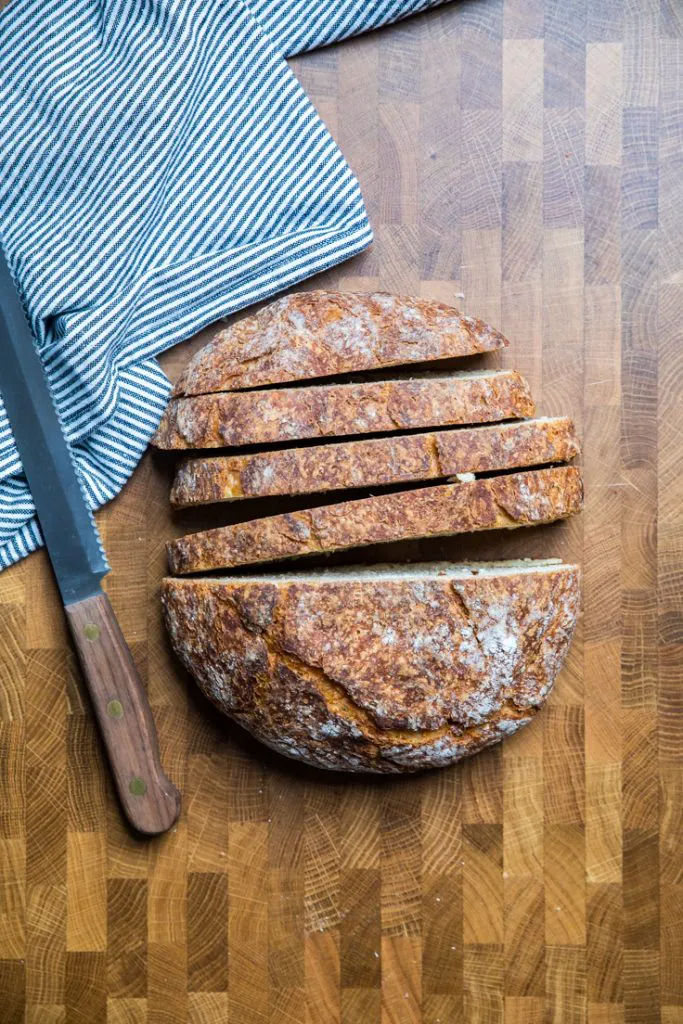Vegan Artisan Bread Recipe: Delicious & Easy to Make at Home
Bake Your Own Vegan Artisan Bread: A Step-by-Step Guide to Deliciousness
Bake Your Own Vegan Artisan Bread: A Step-by-Step Guide to Deliciousness
Can I prep this easy vegan bread ahead?
Yes! You sure can! Once your bowl is covered, you can place the bowl in the fridge up to 2 days before you plan to use it. Just make the recipe as written, cover and place in fridge until ready to use. Alternatively, once made it will last covered at room temperature (on the counter) for up to a week or your can place wrapped tightly in the freezer for up to 3 months.
Yes! Make the recipe all the way through rising. Then, once it has doubled in size, you can place in a ziplock bag and place in the freezer for up to 3 months. To use, let set in the fridge overnight until thawed.
What Can You Use Instead of a Dutch Oven for Bread?
Without Dutch oven we simply create an artificial steam environment for the bread dough. When we preheat the oven just before putting the dough in the oven we pour a cup of water in a dish underneath the dough rack. This will create steam and it will trapped inside the oven surrounds the loaf. This will keeps the crust soft and cool for longer, allowing the yeast to go to work and the loaf to grow.
Pro Tip: Instead of a a Dutch oven simply pour a cup of water in a dish underneath your bread dough rack. This will create a steam environment for the dough to rise and ensure a crispy and crunchy crusty bread.
👩🍳 Expert tips
- If you want a more light and airy bread, only knead it for 30 seconds to a minute
- If you’d like a denser bread, like for sandwiches, knead the dough for 5-10 minutes.
- Get an oven thermometer. You'd be surprised how inaccurate ovens can be. This helps to make sure it gets hot enough to bake the bread.
- Cover the dough with a clean dish towel when rising. Covering it prevents the dough from drying out
- Cover the dough with another bread pan, turned upside down, when baking. Or bake in a dutch oven with a lid. This gets the dough surrounded by steam and forms an amazing, crunchy crust.
- Store your yeast in the freezer! It will keep in there forever
It's important to measure flour correctly when baking because if you have too much flour, it will throw of the water to liquid ratio and could result in dry, crumbly dough.
The most accurate way to measure flour is to use a kitchen scale. But, if you're like me and haven't invested in one of those yet, the second best way to measure flour is to do the spoon method.
First - Since flour compacts on itself, it's important to either stir the flour before measuring it to fluff it up and to ensure you don't get too much flour, or use a spoon to scoop the flour into the cup until it's full
Second, flip over a butter knife to the dull back side, cut some indentations on the top of the flour to help evenly distribute it.
Third, swipe off the excess flour back into the flour jar with the back of a knife, leveling off the top of the flour. This will ensure you have a more accurate cup of flour and don't have too much.
What is the best flour to use for Vegan Artisan Bread?
We prefer using bread flour for this vegan dough recipe; however, all purpose or wheat flour would also work. Even a mix of half all-purpose and half whole wheat will work with this recipe. We cannot currently recommend a gluten free flour or mix at this time. We are adamantly working on creating a gluten free dough.
We prefer using oat milk in this recipe because of the consistency and taste. You can use any non-dairy milk in this recipe. We do recommend that you stay away from strong flavors like coconut, banana, etc. Alternatively, for a cheaper version of this bread, you could even swap for water.



Tegs:
Search
Recent Posts
Subscribe to Updates
Get the latest posts and fashion insights directly in your inbox.